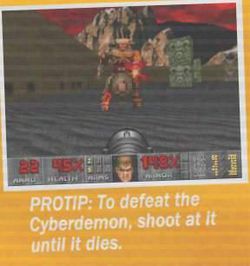 Doom has returned, and with it, an old wound has been opened. Over the years, the GamePro ProTip “To defeat the Cyberdemon, shoot at it until it dies” has become something of a meme. It’s inspired websites. It’s come full circle to become an achievement in the newest game. But mostly, it’s been held up as an example of lazy game journalism. “Ha ha, that kiddy vid rag was so bad, they think this is good advice.”
Doom has returned, and with it, an old wound has been opened. Over the years, the GamePro ProTip “To defeat the Cyberdemon, shoot at it until it dies” has become something of a meme. It’s inspired websites. It’s come full circle to become an achievement in the newest game. But mostly, it’s been held up as an example of lazy game journalism. “Ha ha, that kiddy vid rag was so bad, they think this is good advice.”
The trouble is, it never existed. The ProTip never appeared in GamePro, the kiddy vid rag where I worked for seven years.
ProTips were a GamePro creation and one of the magazine’s hallmarks. Instead of just a dry photo caption or a simple line that redundantly described the image itself, the editorial team decided that a little strategy tip would bring additional value to the reader. You know — you can see screenshots anywhere, but how about some context and content to go with them? That was a little extra you could count on from GamePro, some extra bang for your limited preteen buck, some consideration from the editors and what the audience would appreciate. Depending on the size of the article, there was a minimum number of ProTips you had to create for each review; if I recall, a one-page review had seven screenshots, and writers were asked to caption at least three with ProTips. Originally, I think it may have been more; I always tried for four or five, unless I really needed to use the caption to reinforce a point of praise or criticism, or illustrated some technical issue that gamers should know about before making their purchasing decision. Not all of them were winners — I saw some questionable ones in my time, brought about by deadline crunch — but the majority of the time, real effort went into them. We tried to make them useful, the kind of stuff you’d tell a friend who was playing the game after you — “look out for the boss on level 3, make sure you have plenty of rocket ammo.”
For credibility, reviewers often liked to show screens from late in the game that were not, say, major plot spoilers; some of us were adamant about proving they had finished the game before levying a verdict, and rightfully so. Well, if you’ve played the original Doom to the end, you know there’s nothing to do but shoot and dodge on that last CyberDemon boss — not exactly the stuff of fantastic ProTips. So it is entirely plausible that an editor with a particularly dry sense of humor, like Wes Nihei or Mike Weigand, would have written that caption as a sarcastic joke — the literary equivalent of “well, duh.” So plausible, in fact, that nobody realized that it was actually a joke created by Doomworld.com’s Andrew “Linguica” Stine. Funny? Yes. Possible? Yes. Actual GamePro editorial content? No.
At GamePro, we never wrote down to the audience. (I started there in 1997, but I know this mindset continued long after I left in 2003, under the guidance of John Davison and Julian Rignall.) Even if we knew we had hundreds of thousands of kids and tweens reading every month, we also remembered that no child wants to be treated like one. So we used comfortable language, but we never shied away from using an adult vocabulary. During copy editing, rather than swapping out SAT words, there was a general attitude of “well, if they don’t know that word, this will help them learn it.”
We also didn’t doubt ourselves when creating satirical jokes in the April Fool’s section, or making cultural and historical references in our articles. If the audience didn’t get it, we trusted they’d ask someone or look it up — or at the very least, understand it in broad strokes from the context. Hell, I created elaborate metapuzzles in a few issues; I also hid secret messages in the background of the PC section of the magazine that nobody noticed until I hinted at it more than a year later. The assumption was that the audience would rise to the challenges we put in front of them.
That’s why this meme still bugs me after all these years. It assumes the worst, that our editorial stance was not to put any effort forth — that the writers were lazy bums who thought the reader was just some dumb kid. The opposite was true: We figured the audience wanted to be treated with respect while still having fun, and we created the magazine accordingly.
Linguica fooled everybody for years — and, seriously, well done. But it’s time to stop pointing fingers at GamePro and start applauding for Andrew Stine.
